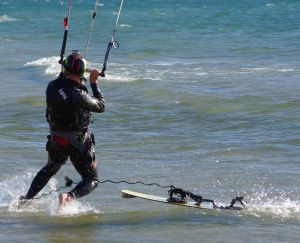Should I Use a Board Leash While Kiteboarding?
Should I Use a Board Leash While Kiteboarding?
One of the inescapable hardships of kiteboarding comes in the form of losing your kiteboard. It happens to everyone, from the new kitesurfer to the advanced rider. And sometimes, after a particularly high velocity crash or in wavy conditions, it can seem impossible that you'll ever recover your kiteboard with how far you were dragged. Naturally, that led to some kite surfers attaching leashes to their kiteboard so as to never lose it. You may find yourself asking the question, is a kiteboard leash right for me? The forthright answer to that question is no, you should not attach a board leash to your kiteboard. The answer boils down to simple physics.
 With minor falls, a leash attached to your kiteboard doesn't pose much of a threat. But then again, small falls are easy to recover from, and the board is nary a far distance away. Larger, more powered falls is where the danger in a leash manifests itself. Effectively, you have a powerful, unwieldy kite attached to you that has a tendency to pull you across the water for several meters before depowering. In the event the board submarines, or goes underwater, a stupendous amount of resistance is going to be created. When that board finds its way out of the water, it is going to be propelled at you at an incredible speed. You might be fortunate and be missed, or merely grazed by the kiteboard. Or you may be less lucky, and get knocked out or have a chunk taken out of you. Helmets and impact vests found their way into kiteboarding precisely for this reason, and even still they don't offer much protection from a kiteboard coming at you at mach 10.
With minor falls, a leash attached to your kiteboard doesn't pose much of a threat. But then again, small falls are easy to recover from, and the board is nary a far distance away. Larger, more powered falls is where the danger in a leash manifests itself. Effectively, you have a powerful, unwieldy kite attached to you that has a tendency to pull you across the water for several meters before depowering. In the event the board submarines, or goes underwater, a stupendous amount of resistance is going to be created. When that board finds its way out of the water, it is going to be propelled at you at an incredible speed. You might be fortunate and be missed, or merely grazed by the kiteboard. Or you may be less lucky, and get knocked out or have a chunk taken out of you. Helmets and impact vests found their way into kiteboarding precisely for this reason, and even still they don't offer much protection from a kiteboard coming at you at mach 10.
Reel leashes are sometimes employed as a safer alternative, but can still pose a danger. The intention with reel leashes is that they are only connected after a wipe-out, attaching the board to you so it doesn't drift away as you work to relaunch your kite. Risk is still present however, as the kite can launch off the water more powerfully than predicted, causing you to be pulled suddenly across the water. From personal experience, I've found that if I crash next to my board, the best option is putting it on my feet and using it as leverage to help relaunch my kite. The added resistance prevents you from being towed downwind by the kite as much, making relaunch easier.
 Rather, instead of attaching a leash to your kiteboard, there is a much safer solution - learning how to body drag! When body dragging, you'll effectively use your body as a rudder. If you are comfortable steering the kite with one hand (a skill that can be honed with a trainer kite), use a hand to further drive yourself upwind towards your downed kiteboard. Keep in mind that drastic turns can undo your progress as the kite pulls you downwind, so tack as straight as possible and turn only when necessary, steering the kite gently. Practice several times before actually going out on the water, setting upwind targets to drag to. Not only will this make you a stronger kiteboarder, but it'll make sure you spend those windy days on the water instead of in a hospital bed!
Rather, instead of attaching a leash to your kiteboard, there is a much safer solution - learning how to body drag! When body dragging, you'll effectively use your body as a rudder. If you are comfortable steering the kite with one hand (a skill that can be honed with a trainer kite), use a hand to further drive yourself upwind towards your downed kiteboard. Keep in mind that drastic turns can undo your progress as the kite pulls you downwind, so tack as straight as possible and turn only when necessary, steering the kite gently. Practice several times before actually going out on the water, setting upwind targets to drag to. Not only will this make you a stronger kiteboarder, but it'll make sure you spend those windy days on the water instead of in a hospital bed!
Jake Mitchell
Age: 23
Weight: 180
Years Kiteboarding: 3
Leash Encounters: 0
